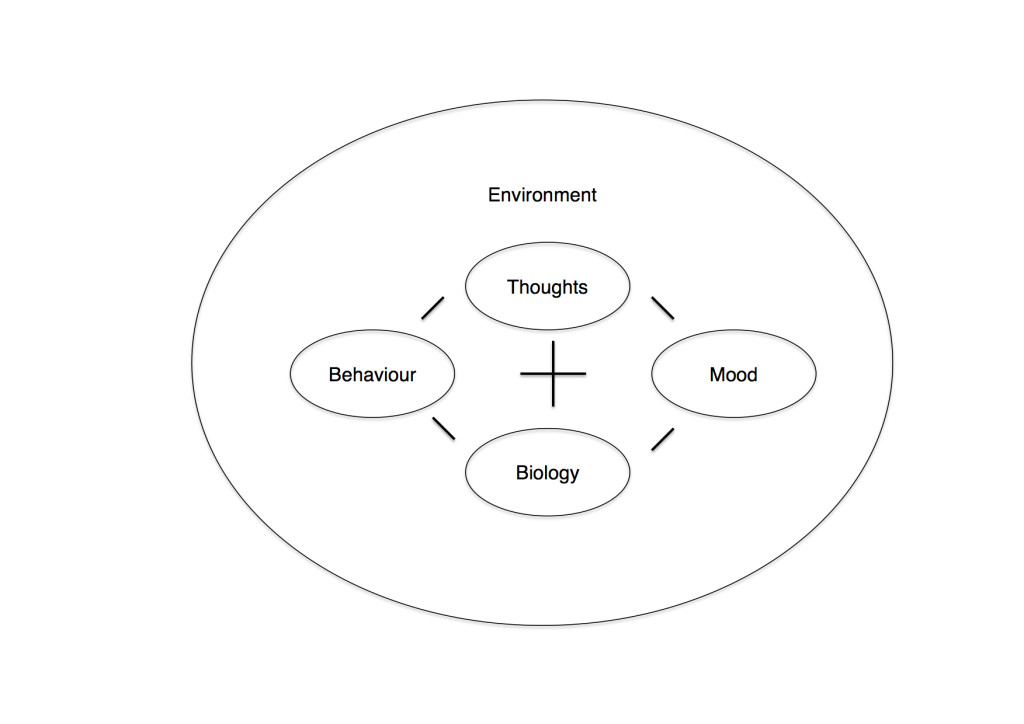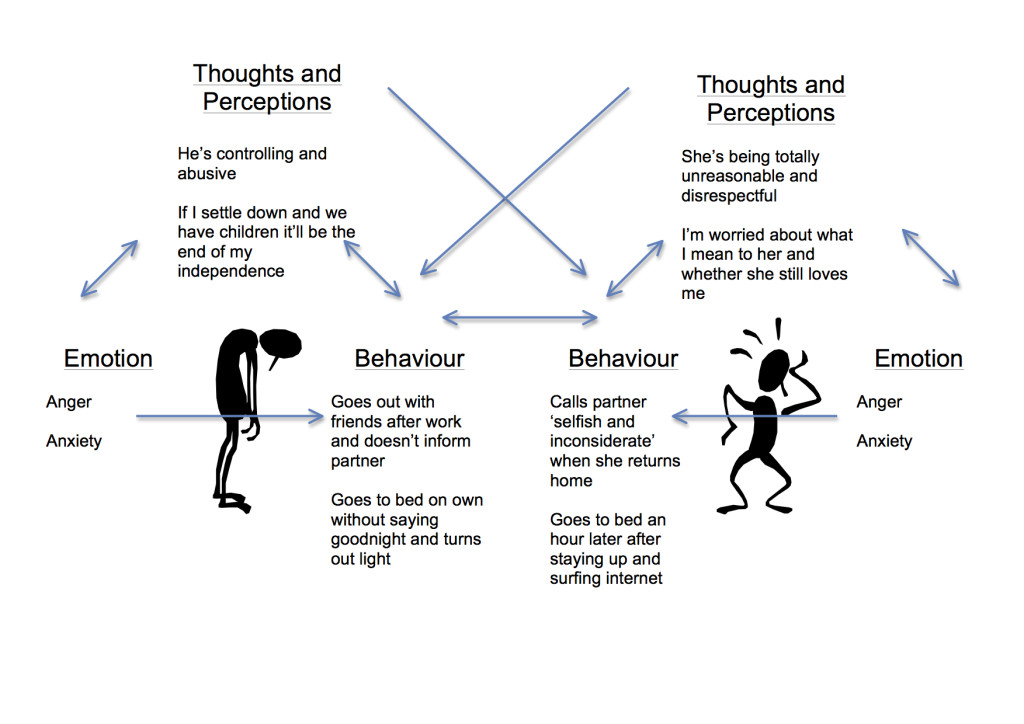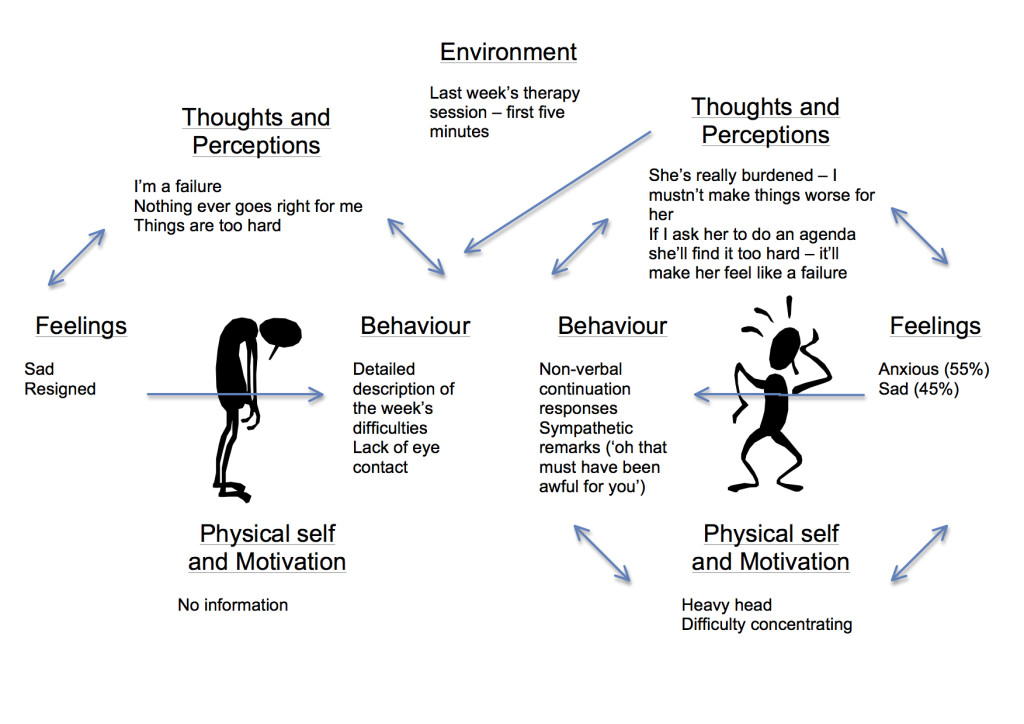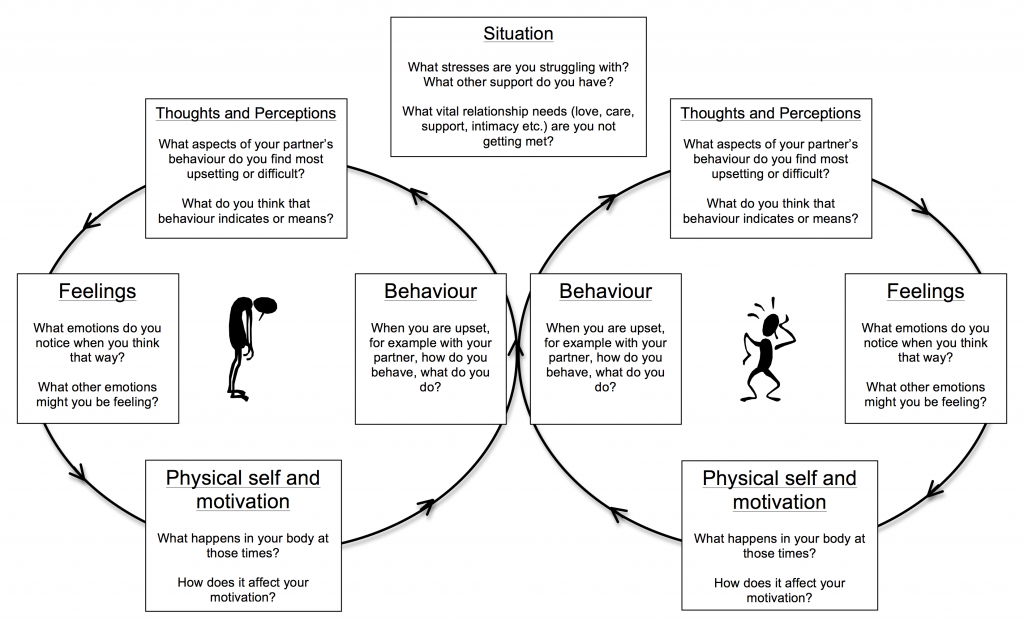 Figure 1: the nine-part model: A tool for sharing dyadic formulations (Grimmer, 2013)
Figure 1: the nine-part model: A tool for sharing dyadic formulations (Grimmer, 2013)
If you’re familiar with Padesky & Mooney’s (1990) generic model of CBT, commonly known as a five-part model or a Hot Cross Bun diagram, you will recognise the general format employed in the nine-part model (Figure 1). The generic model (Figure 2) is a diagrammatic problem formulation used to help clients understand their difficulties by eliciting links between the current environmental context and appraisals of events, emotional and physiological responses, and subsequent actions.
The generic model however doesn’t always do a good job of helping a client to understand the way events unfold between themselves and others that might perpetuate problems. Functional analysis is a tool for examining the relationship between events and their consequences in terms both of reinforcement and of the perpetuation of circumstances that are unrewarding or actively aversive. An example is the TRAP (Trigger, Response, Avoidance Pattern) and TRAC (Trigger, Response, Alternative Coping) model used to formulate the impact of avoidance on depression using Skinner’s operant conditioning concept of negative reinforcement in Behavioural Activation for Depression Figure 3 (Jacobson, Martell & Dimidjian, 2001)
Beck’s generic cognitive model is predicated on the hypothesis that cognitions mediate between circumstances and their emotional consequences (Beck, 1976). Functional analysis, on the other hand, focuses on contingencies (i.e. reinforcement) by identifying and making explicit antecedent conditions, behaviours and consequences (ABCs). Antecedents are the conditions that give rise to specific acts, that is, the controlling variables that elicit behaviours. Consequences are reinforcing events that follow from specific acts occurring in specific contexts (Jacobsen & Christensen, 1996). The five part model seems to work best when used as a snapshot of a moment when affect is at its strongest so that the “hot thought” can be elicited prior to cognitive reconstruction. The ABC model has the benefit of demonstrating how choices about behaviour in any given situation determine the likelihood of that behaviour recurring, as a consequence of its reinforcement value. Both models help to communicate to clients that a change in one domain can have positive consequences in the others. However both, I would argue, can be developed further in combination to enable therapists to formulate the interactions of dyads, such as a couple in an intimate partnership, a parent and child, or a therapist and client, to help demonstrate the ways that each person influences, and is influenced by, the other.
Systemic family therapy models, in particular the Milan model, focus on the impact of behaviours and beliefs within an interpersonal system, such as a family (Selvini Palazzoli, Boscolo, Cecchin and Prata, 1980). A reciprocal pattern of influence is elicited, typically through circular questioning that serves four functions: to 1) define the problem; 2) describe sequences of interaction; 3) compare and classify behaviour, beliefs, values, thoughts, feelings and relationships; and, 4) intervene through encouraging new behaviour (Brown, 1997). Hypotheses about the reciprocal impact of behaviours and appraisals are typically presented verbally or in the form of a therapeutic letter.
The existential phenomenology of R. D. Laing and the Personal Construct Psychology of George Kelly each focus on individual phenomenology as experienced within reciprocity of experience. Both employ the metaphor of two mirrors placed opposite each other, each infinitely reflecting the other (Monte, 1980). This constructivist model of interpersonal phenomenology regards experience as essentially co-constructed by active, meaning-making agents. In a constructivist epistemology we cannot glance around the mirror to apprehend reality directly, only become aware of the continual co-construction of experience.
Teichman developed a reciprocal model of depression (Teichman & Teichman, 1990) that integrated Betalanffy’s system theory, Bandura’s “reciprocal determinism” and Beck’s model of depression. The model was further explicated in a case report (Teichman, 1992) in which it was hypothesised that there is a constant reciprocal process between cognition, emotion, behaviour and environment occurring both within (intrapsychic) and between (interpersonal) persons. Symptoms are therefore a consequence of “dysfunctional reciprocities and relationships” (p332) and could be mapped as a conceptual tool to guide interventions (Figure 4).
The nine-part model clearly shares many conceptual and visual features of Teichman’s Reciprocal Model, although when I developed the nine-part model in 2006 I was unaware of Teichman’s work. The nine part model arose out of practical necessity when working in a primary care psychological therapy service in South Auckland, New Zealand. The work brought me into contact with many Maori (tanagata whenua) families. In order to try to conceptualise individual difficulties I endeavoured to try to understand the cultural context in which they arose. As I worked with tangata whenua clients I learned that individuation is intimately tied to tribal affiliation and familial role. I wanted to find a way collaboratively to develop and share hypotheses about the maintenance of distress that reflected both intrapersonal and interpersonal factors.
In trying to encompass multiple perspectives on events I started to draw mirror images of the five-part models I had been using and found I was able to formulate and communicate a reciprocal maintenance of distress in diagrammatic form . Whilst this model remained limited to dyads I found that it started to represent some of the complexity of real people living their lives in a world that does not respond passively to their actions, but also appraises and acts in response itself.
It is my opinion that the nine-part model has some advantages in some situations over Teichman’s model as it represents a less deterministic relationship between elements and has greater flexibility in demonstrating pathways of influence between elements. I have used this model subsequently in my everyday practice with individuals, couples and in supervision. I have also taught the model as part of the process of assessment and formulation of couples in Couple Therapy for Depression (Hewison, Clulow & Drake, 2014) to help therapists from differing backgrounds to formulate and share reciprocal maintenance cycles. I hope that the following examples will demonstrate that it can be of practical value in the everyday clinical work of psychotherapists.
Kuyken, Padesky and Dudley (2009) discriminate between three levels of conceptualisation: the descriptive, cross-sectional and longitudinal. The nine-part model is intended to be a tool that can accommodate all three levels of formulation, but primarily the descriptive and cross-sectional. It is both a tool for the therapist to conceptualise the relationship between intrapsychic and interpersonal factors in the maintenance of distress, but also, crucially, to communicate that description. Whilst it draws on cognitive, behavioural, systemic and constructivist perspectives it makes no a priori assumptions about the factors that mediate distress. It is in essence a reconfiguration of the generic model to formulate dyadic interactions as dynamically evolving interactions between participants who are actively making meaning of their encounters and acting on that understanding, whether that meaning is implicit or explicit. Through repeated use, cross-sectional themes emerge, and with the addition of individual vulnerability factors as moderating and mediating influences on cognitive expectancies and behavioural repertoire it is also possible to incorporate a longitudinal perspective.
Because of its increased complexity the nine-part model suffers and benefits from both these factors. Specifically the model directs clients and therapists to the understanding that behaviour has both a direct impact on the other person but might also affect the other person indirectly by altering the environmental context. In a simple example, if one person is a spender and the other a saver then the behaviour of one partner will alter the resources available to the other. Similarly the nine-part model makes clear that appraisals of both the environment and of each other’s behaviour are subject to misinterpretation, distortion or selective attention.
These areas, which are unique to the nine-part model, can be represented as follows (Figure 5):
Over the years that I have been using the model I have come to some conclusions about how it is best used in practice. Firstly, in the generic model the environment is drawn as encompassing the individual and the position of the other four elements is arbitrary, leaving no easy way to describe an interaction between behaviour and its environmental consequences.
In the nine-part model the positioning of elements is important. Behaviour is drawn on the left side of the right-hand figure and vice versa. This is done so that the interactions between behaviour can be shown without the necessity for reference to the thoughts, emotions and physiological responses that are happening ‘behind the scenes’, so to speak. The impact of significant distressed behaviour, such as the climax of an escalating pursuer-distancer interaction, can therefore easily be described and simple ‘shaping’ processes explored.
Secondly, the environment in which a specific interaction took place is placed at the top of the diagram. This is to help the clients identify salient features of the circumstances in which the events in question took place. An example might be ‘at home, Thursday evening, 9-30pm, children in bed’. This allows or the impact of particular circumstances to be explored, for example when asking, “What was it about this time and place that made you vulnerable to this type of interaction?” I have also included unmet relationship needs in the situation. Although these are more properly properties of each individual’s cognitions and affect, they can , for the sake of utility, be regarded as an environmental context that is held in common between partners. For example, a lack of support is both a perception by partners and an overall condition of the relationship when a deficit in support constitutes both an antecedent and a consequence of the interactions between the couple.
Thoughts and perceptions are placed above the figures (“screen beans” are optional, stick figures, the person’s name or initials, or emoticons do just as well, or even no figure at all). This enables the relationship between a specific behaviour and its interpretation to be described using simple arrows. It also enables more vulnerable thoughts that aren’t being shared with each other to be disclosed, improving the chances that a couple will take an empathic stance towards each other.
As can be seen from the example of a couple shown below, the surface thoughts are focused on perceived transgressions of rights and entitlements to freedom and respect, leading to the emotion of anger and critical (attack) or avoidant behaviour. Through greater exploration of the meaning of each other’s behaviour the partners are able to disclose their anxiety and uncertainty about the relationship, thus making each other’s behaviour more easily comprehensible to the other. What the nine-part model adds to a verbal elicitation of this dynamic is the ability to represent these factors graphically and therefore to make the formulation both shared and portable (Figure 6)
The following is another example of how the nine-part model can be used to formulate a typical pattern of escalation in a couple. The therapist can start by eliciting observable behaviour and then move on inquire about underlying thoughts and assumptions using standard Socratic questioning. For example asking: “When you noticed that David didn’t respond to you asking him to put his dirty work clothes in the laundry, what went through your mind?” and reciprocally, “When Helen said to you in loud voice that she’s ‘fed up with having to pick up after you’ what did that mean to you?”
By following up with questions about each partner’s emotional and physical responses, and through the use of ‘downward arrow’ questions, underlying meaning and an accompanying pattern of reciprocal responding can be elicited. This line of questioning can be done in either a linear fashion, as above, or using circular questions. The most salient answers to these questions are then transcribed on to the nine-part model. This diagram then becomes the property of the dyad. Through using the nine-part model repeatedly as a descriptive tool to describe maladaptive or distressed interventions cross-sectional themes can be elicited.
This knowledge can be of use to couples in a number of ways. It can help couples to identify recurrent themes of difference that don’t respond well to problem solving. It can help elicit polarization as couples attempt to regulate key aspects of the relationship, such as interpersonal distance. It can help couples identify the mutual traps they find themselves in whereby they are unable to stop acting in ways that are maladaptive, even when they recognize that their behaviour doesn’t lead to the outcomes they hope for. The task of communicating an accurate and credible couple formulation comprising a named theme, polarization process and mutual trap has been described as the primary task of Integrative Couples Therapy (Jacobson and Christensen, 1996).
In addition, by representing the formulation diagrammatically couples can be helped to identify and correct the unfounded and inaccurate assumptions each makes about the other’s intentions and motives, for example where verbal interactions that are intended to be supportive are perceived as criticisms. It can also help couples to appreciate the undisclosed or unobserved intensity of emotional responses each is experiencing, so that they can respond to each other more appropriately.
The functions described above can also be achieved through a blend of careful questioning and empathic validation. However, transcribing the results of such conversations into a straightforward diagrammatic formulation seems to help couples better to distance themselves from the content of their unhelpful interactions. This can be useful when reprocessing conflict where the risk is that the couple will start to argue again as they become engaged with the content of their disagreement.
As a tool to help couples disclose their emotions it can help them feel a greater sense of empathy and connection with each other. It enables discussions to take place about alternative ways of behaving, more accurate perceptions, and more functional ways to disclose or manage high levels of negative emotion.
The nine-part model does not necessarily need to comprise all nine elements to be useful. Rather it is the depiction of reciprocal patterns of interaction that is its main function. However, sometimes completing all nine aspects is useful, as in Figure 7. In this example the therapist chooses to focus on the most distressing part of a conflict. The ‘hot thoughts’ experienced at moments of severe conflict are highly likely to be implicated in escalation of arguments and in actions that do lasting damage to the couple’s sense of unity and trust. Thoughts have been rated for their degree of credibility at the time of the incident and emotions for their degree of intensity. Re-rating beliefs and emotions after cognitive reconstruction can help provide feedback to clients about changes in emotional responding or problematic beliefs that reinforce a sense of agency and control.
In addition to its obvious use with couples the nine-part model can also be used with individuals wherever there is an interpersonal element to their problems, such as in depression, social anxiety disorder or obsessive-compulsive disorder, where it can be used as an adjunct to a disorder-specific model such as the Clark and Wells model of social anxiety (Clark and Wells, 1995). In social anxiety disorder the nine-part model helps to elicit assumptions that the client is making about how others think and feel about them when in a social situation and to highlight how the use of safety behaviours, such as not making eye contact, can have real-world interpersonal consequences that contaminate the social situation and confirm the anxious anticipation that others will judge the client negatively. In OCD or depression the impact of excessive reassurance seeking can be shown in a way that makes both partners’ reactions more understandable and therefore open to change.
The nine-part model is also a useful tool in supervision, especially to understand a therapeutic rupture, client non-compliance, or therapist non-adherence. A first step is to elicit the client’s behaviour that is regarded as problematic, then to elicit the therapist’s thoughts, emotional responses and behaviour. Assumptions about the client’s thoughts and feelings are then elicited and tested against available evidence and new ways of behaving are formulated.
For example, a supervisor-supervisee dialogue might go as follows:
Therapist: You say that you’re finding yourself really reluctant to set an agenda with this client. When does the problem occur?
Supervisee: Right at the start, as soon as she comes in the room.
Therapist: And what goes through your mind at that moment?
Supervisee: Oh just that she looks so burdened and down. I don’t want to add to her problems by asking her to do something that she might find really hard
Therapist: and how do you feel when those thoughts are in your mind?
Supervisee: really sad for her, and also quite anxious that I’ll make her feel like a failure and that’ll make her feel worse
Therapist: and because you think that if you ask her to set an agenda it’ll make her feel like a failure and worsen her low mood, and those thoughts make you anxious, what do you do?
Supervisee: I just ask her how her week has been and try to be sympathetic by telling her I can see how awful things are for her
Therapist: and what do you notice about her behaviour when you do that?
Supervisee: well she seems to go into herself. She starts recounting the week’s list of troubles in minute detail. It’s almost as if she’s ruminating out loud.
Therapist: and how do you imagine she’s feeling as she does that?
Supervisee: probably worse
Therapist: and what effect might that have on her depressive thinking?
Supervisee: well I know she’s not feeling as though she’s any more in control of her life. It’s more like she’s reinforcing her sense of failure. We just seem to go round and around without making any progress
Therapist: let’s see if we can make a diagram out of this so we don’t have to try to hold it all in our minds while we think about other ways of looking at the situation, or other things you could do. Is that OK?
In summary, the nine-part model is a diagrammatic formulation of dyadic interactions that is used to make recurring patterns of distressed interactions more available for treatment interventions. Whilst it is has not been formally tested for its utility in clinical trials its use in both clinical and teaching practice suggests that it is a useful adjunct to individual formulation. Downloadable blank templates are available below.
Nine-part model blank with figures
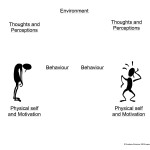
Nine-part model blank without figures

Andrew Grimmer, 2013
How to cite this article (APA style):
Grimmer, A.G. (2013). The nine-part model: A tool for sharing dyadic formulations. Retrieved from www.bristolcbt.co.uk/publications/the-nine-part-model-dyadic-formulation on DD/MM/YYYY
References
Beck, A. T. (1976). Cognitive therapy and the emotional disorders. Oxford: International Universities Press
Brown, J. (1997). Circular questioning: An introductory guide. Australia and New Zealand Journal of Family Therapy 18(2) 109-114
Clark, D. M. & Wells, A. (1995). A cognitive model of social phobia. In R. Heimberg, M. Liebowitz, D. A. Hope, & F. R. Schneier (Eds.), Social phobia: Diagnosis, assessment and treatment. (pp. 69–93). New York: Guilford Press.
Hewison, D., Clulow, C. & Drake, H. (2014). Couple therapy for depression: A clinician’s guide to integrative practice. Oxford: Oxford University Press
Jacobsen, N.S. & Christensen, A. (1996). Acceptance and change in couple therapy: A therapist’s guide to transforming relationships. New York, NY: W.W. Norton & Company
Jacobson, N.S., Martell, C.R., & Dimidjian, S. (2001). Behavioural activation treatment for depression: Returning to contextual roots. Clinical Psychology: Science and Practice 8(3) 255-270.
Kuyken, W., Padesky, C. A., & Dudley, R. (2008). Collaborative case conceptualization: Working effectively with clients in cognitive-behavioral therapy. Guilford Press.
Monte, C.F. (1980). Beneath the mask: An introduction to theories of personality (2nd edition). New York, NY: Holt, Rinehart and Winston
Padesky, C.A. & Mooney, K.A. (1990). Presenting the cognitive model to clients. International Cogntive Therapy Newsletter, 6, 13-14. Retrieved from http://padesky.com/newpad/wp-content/uploads/2012/11/v6no_1_2_present_model1.pdf on 11/12/13
Selvini-Palazzoli, M., Boscolo, L., Cecchin, G., & Prata, G. (1980). Hypothesizing, circularity and neutrality: Three guidelines for the conductor of the session. Family Process, 19, 73-85.
Teichman, Y. (1992). Family treatment with an acting-out adolescent. In A. Freeman & F. M. Datillio (Eds.) Comprehensive casebook of cognitive therapy (pp. 331-346). Springer US.
Teichman, Y., & Teichman, M. (1990). Interpersonal view of depression: Review and integration. Journal of Family Psychology, 3(4), 349.

